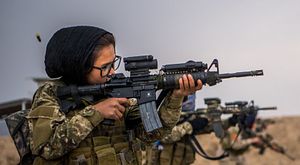Although the Afghan government and its U.S.-led NATO allies have strived to make joining the Afghan National Defense and Security Forces (ANDSF) an attractive offer for Afghan women, these efforts have fallen far behind achieving any set target. In 2010, the Afghan government and its NATO partners set out to have women make up 10 percent of Afghan security forces by 2020. Realizing their failure, instead o f looking deeper for the causes and correcting them accordingly, they simply chose a new target and a more relaxed deadline. According to the revised plan, it is expected that 5,000 women will join the National Army and 10,000 women will serve in the Afghan National Police by 2025.
According to the latest report by Special Inspector General on Afghanistan Reconstruction (SIGAR) on U.S. reconstruction funding for Afghanistan security, there are roughly around 4,500 women in ANDSF. They only comprise 1.4 percent of ANDSF personnel. The report that presents records as of August 2017, notes that women in the Afghan Special Security Forces (ASSF), which numbered 120, saw the greatest decrease since the previous quarter, losing 20 personnel. Replacing the coalition’s female only unit, these forces are considered to play a crucial role in counterterrorism efforts, especially in operations involving women.
In Afghanistan, of course, security is the biggest challenge. However, there are other hurdles that need to be addressed at the same time. Women’s feeling of insecurity in the public sphere in general and in male-dominated institutions in particular, traditional patriarchal norms, lack of or weak support mechanisms for victims of violence and harassment, and women-unfriendly bureaucracy bar Afghan women from fully assuming their desperately needed role in Afghan society. To tackle this problem, however, the Afghan government needs to take a more comprehensive approach that addresses the broader and deeper social and structural problems.
Start with the education system. Though there have been significant achievements in education in terms of quantity compared to the pre-2001 era, the quality of education, however, remains poor. One of the Afghan education system’s serious shortcomings is the way women are portrayed in school textbooks. The education system indoctrinates children with gender biases from early on and reinforces stereotypical gender roles. Unfortunately, as far as I can recall from my own experiences at Kabul University, gender (mis)perceptions are never challenged even in Afghanistan’s higher education institutions. To foster women’s participation in public life sustainably, the country’s education system needs serious reform. After a thoughtful revision of school textbooks, gradual countrywide co-education is the first step to make male-female interactions happen with a normal attitude inside Afghanistan.
Promoting women’s overall participation in the labor force in general will also increase women’s presence in the security sector in particular because it will ease the overall social and family pressures related to work outside of the home. According to a 2017 World Bank estimation, women make up slightly above 17 percent of the Afghan labor force which is the lowest in the region. One might argue that this is due to weak government control, or in some cases a complete a lack of control, over Afghanistan’s territory. This is true about some provinces. But, unfortunately, the story is not very different in big cities with relatively few security incidents, such as Mazar-e Sharif and Herat and highly peaceful provinces such as Bamyan and Daikundi. Effective implementation of the Eradication of Violence Against Women (EVAW) law, raising awareness on sexual harassment and gender issues among all segments of society and stopping mullahs from using public platforms, such as Friday sermons and media, against women through the Ministry of Hajj and Religious Affairs could help open more spaces for women.
Finally: let women lead. Although the current National Unity Government has supported more women in some semi-leadership roles, the country needs more women leaders, especially in the security sector. Having more women leaders will help in generating more gender aware policy development and program implementation as well as more understanding of female employee and constituent concerns. Moreover, studies show that women contribute to honest government more than men while the adverse effects of corruption are greater on women. Afghanistan has one of the most corrupt governments in the world, according to Transparency International’s Corruption Perceptions Index 2017. Doesn’t it sound plausible for the Afghan government to have more women both to fix itself and alleviate the suffering of Afghan women?
Jawad Zawulistani a Fulbright Scholar at the Heller School for Social Policy and Management, Brandeis University pursuing a master’s degree in Conflict Resolution & Coexistence.

































